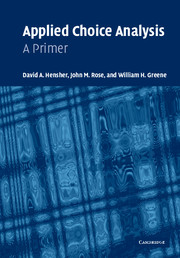Book contents
- Frontmatter
- Contents
- List of figures
- List of tables
- Preface
- Part I Basic topics
- 1 In the beginning
- 2 Basic notions of statistics
- 3 Choosing
- 4 Paradigms of choice data
- 5 Processes in setting up stated choice experiments
- 6 Choices in data collection
- 7 NLOGIT for applied choice analysis: a primer
- 8 Handling choice data
- 9 Case study: mode-choice data
- 10 Getting started modeling: the basic MNL model
- 11 Getting more from your model
- 12 Practical issues in the application of choice models
- Part II Advanced topics
- Glossary
- References
- Index
9 - Case study: mode-choice data
Published online by Cambridge University Press: 05 September 2012
- Frontmatter
- Contents
- List of figures
- List of tables
- Preface
- Part I Basic topics
- 1 In the beginning
- 2 Basic notions of statistics
- 3 Choosing
- 4 Paradigms of choice data
- 5 Processes in setting up stated choice experiments
- 6 Choices in data collection
- 7 NLOGIT for applied choice analysis: a primer
- 8 Handling choice data
- 9 Case study: mode-choice data
- 10 Getting started modeling: the basic MNL model
- 11 Getting more from your model
- 12 Practical issues in the application of choice models
- Part II Advanced topics
- Glossary
- References
- Index
Summary
Few things are harder to put up with than the annoyance of a good example.
(Mark Twain, 1835–1910, Pudd'nhead Wilson, 1884)Introduction
In this chapter, we provide a detailed description of the case study alluded to throughout the book. You should already be familiar with aspects of the case study from your reading to date. The question for us was whether we detailed the case study early in the book, later in the book (as we have here) or discussed aspects of it throughout the book without ever providing the reader with a detailed overview of how the actual study proceeded.
Detailing the case study earlier in the book risked alienating the reader through the use of the expert language necessary to relate the hows and whys of the study. By leaving the detailed description to now, we feel that the reader should be equipped with a level of expertise in the language of choice to understand what actually occurred. We will, for this chapter, use the language of the expert (or, at least, the more informed). If you have absorbed the material in previous chapters, then what we write here should be easily understood.
Study objectives
The case study, the data for which we use in later chapters to demonstrate the more practical aspects of choice modeling, was part of a 1994 study into Greenhouse Gas Emissions (GGE) commissioned by the Australian Federal Government. An important feature of the GGE study was to develop a data base to describe the characteristics of the population of households and passenger vehicles in a base year.
- Type
- Chapter
- Information
- Applied Choice AnalysisA Primer, pp. 254 - 307Publisher: Cambridge University PressPrint publication year: 2005



